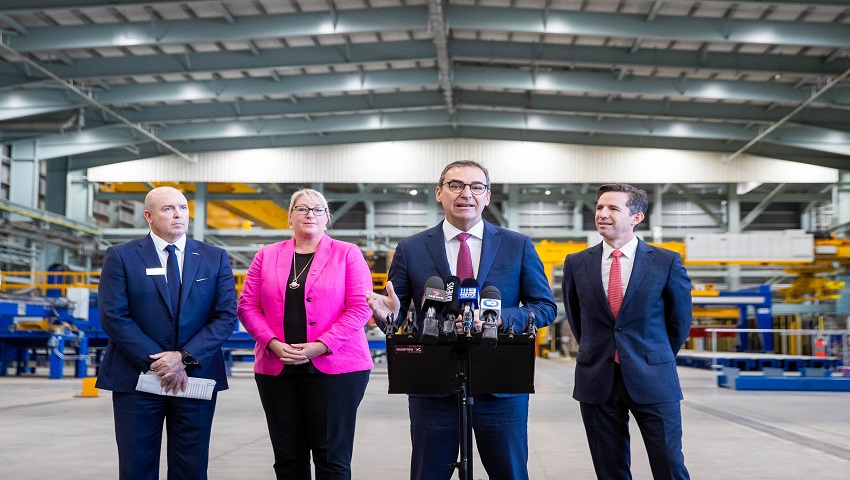In a year that has seen tragic loss of life, millions lose their jobs, some of the world’s biggest economies devastated and major events cancelled across the globe, right here in Australia’s backyard there is some good news explains BAE Systems Maritime Australia, managing director, Craig Lockhart.
To continue reading the rest of this article, please log in.
Create free account to get unlimited news articles and more!
At the Osborne Naval Shipyard, Australian workers have cut Australia steel and the prototyping phase of the biggest surface shipbuilding project in Australia’s defence history, the Hunter Class Frigate Program, will commence.
This is an amazing achievement and a credit to the entire shipbuilding team, and our Commonwealth and industry partners.
Through the Hunter program we will build nine of the world’s most potent anti-submarine warfare frigates for the Royal Australian Navy.
The Hunter class frigates are based on BAE Systems’ Type 26 Global Combat Ship design, and are being modified to meet Australian requirements.
But before we cut steel on the first frigate in 2022, we will undergo what’s known as the prototyping, or ‘test’, phase, designed to provide us with a solid operational foundation for the program.
During this critical period, we will use Australian steel to build five representative ship blocks, and the systems, processes, facilities and workforce competencies will be established and thoroughly tested.
By ‘tested’, we mean that we want to push the new shipyard, with its state-of-the-art machinery, to its limits. Prototyping is designed to stretch the capability of the processes, so we know how to adjust and maximise the utility of the digital yard and are more than prepared to support full production of Ship 1.
And it’s not just the machinery that will be out through its paces – our employees’ skills and abilities will be assessed to ensure they will meet the rigours of construction.
Commencing prototyping is possible because of the rapid progress we have made since the Australian government awarded ASC Shipbuilding the Hunter program contract in December 2018.
Since then, we have been growing our workforce – and we recently hired the Hunter program’s 1,000th employee.
We’ve been working closely with our supply chain, and even though we haven’t been able to hold in-person briefings this year, we have held three successful webinars, enabling meaningful engagement in real-time.
Nearly 1,400 Australian small and medium businesses have registered their interest in the Hunter program via the online Industry Capability Network, and in the last six months we’ve awarded prototyping contracts to a number of Australian businesses – including two Australian steel manufacturers, BlueScope Steel AIS and Infrabuild Steel Centre.
There will be many more to come. We are committed to supporting Australian suppliers so that we can develop the sovereign industrial capability required for our nation to independently design, build and sustain its future warships.
I am incredibly proud that nearly two years to the day since we signed the contract to undertake this national endeavour, we are ready.
Ready to cut steel on prototyping.
Ready to fire up the shipyard and watch it hum with activity.
Ready to embark on the next phase of this program that will provide job security for generations of Australians.
The Hunter Class frigate is based on the Type 26 Global Combat Ship design, which supports a close partnership between the UK Royal Navy, Royal Canadian Navy and the Royal Australian Navy, all of whom have selected a variant of the design for their anti-submarine frigate programs, supporting greater operational, training and intelligence ties.
The prototyping phase of the Hunter Class Frigate Program is integral to enabling the delivery of the Hunter Class frigates and leading to a Continuous Naval Shipbuilding industry in Australia.
The prototyping phase of the Hunter Class Frigate Program will run for three years until 2023. The construction phase of the Hunter program is scheduled to commence by end 2022. The nine Hunter Class frigates will be based on the BAE Systems Type 26 Global Combat Ship currently under construction for the Royal Navy and will replace the eight Anzac Class frigates when they enter service beginning in the late 2020s.
The Hunter Class is billed as an anti-submarine warfare (ASW) centric vessel delivering an advanced ASW capability to the Royal Australian Navy at a time when 50 per cent of the world’s submarines will be operating in the Indo-Pacific region.
BAE Systems Australia announced that it had selected Lockheed Martin Australia and Saab Australia as combat systems integration industry partners, responsible for delivering the Australian-designed CEAFAR 2 Active Phased Array Radar, Lockheed Martin-designed Aegis combat management system and Saab Australia 9LV tactical interface.
The $35 billion program sees ASC Shipbuilding become a subsidiary of BAE Systems throughout the build process beginning in 2020 at the Osborne Shipyard in South Australia, creating more than 4,000 jobs.
BAE Systems expects the Australian industry content for the Hunter Class build will be 65-70 per cent, which will create and secure thousands of jobs for decades.
At the end of the program, the Commonwealth will resume complete ownership of ASC Shipbuilding, thereby ensuring the retention in Australia of intellectual property, a highly skilled workforce and the associated equipment.
SEA 5000 is expected to support over 500 Australian businesses who have been pre-qualified to be part of the Hunter Class supply chain, with the Australian steel industry in particular benefiting from the 48,000 tonnes of steel required to build the ships.
Craig Lockhart is managing director of BAE Systems Maritime Australia.

 Login
Login







